Iain
Toothy, stripey, greedy, lady, ‘salmon’
After a previous days 3.45 am start and 9pm finish chasing bass there was only one thing for it. Yep, get up even earlier at 3am to try and catch a salmon from the famous River Test with an offered start time of first light due to the unseasonably hot weather. Now salmon fishing can be tough at the best of times but in relatively warm water, in hot and bright conditions it was going to be harder than ever but then since when was salmon fishing easy! Even knowing that it would be a warm day, I was still amazed to see that it was still 18oC at 3am according to the dial on the car and so it was really nice to get to the relative cool of the river bank bang on first light. The river looked to be in perfect condition which being spring fed, is one of the big advantages of a chalk stream at a time when salmon fishing on the Avon was suspended due to water temperatures exceeding 19oC.

I decided to start with the fly rod which was a single handed #7/8, coupled to a floating line, 10’ of leader and a salmon ‘nymph’. These nymphs are in fact more like dog nobbler trout lures and with there still being plenty of water I had been advised by the water keeper to tie some up with double 5mm tungsten beads as in the photo. They are very simple to tie with mine consisting of a marabou tail, flash of choice (I love the silver scales charteuse magnum flash) which is tied in to create a strip of flash either side of the tail (pearl crystal flash is also good for that) and a double strand for a flash back over a body of black ostrich herl. Finally I swap to a hot orange or red thread to create a slim hot spot behind the beads. A quick coat of varnish or Solarez thin UV gel to seal and protect the thread and your done.

Now these are beasts of a fly even with just one bead and so are not for casting at any length because get it wrong and it’s like a bullet hitting you! Instead they are for use close in around the very large flow diverters that have been built either side of the river to create deep scour holes in which the salmon lie up. So with just a few inches of fly line beyond the tip you flick them out using a mini roll cast to 2 or 3 feet above the end of the diverter – they are heavy enough that you can even throw them out!. Let the fly sink to the bottom and then slowly lift to the surface, hold for a second and then let them sink this time a few inches further downstream. You repeat that sort of sink and draw until you’ve got to the tail of the scour hole. Flick out again a bit further out and repeat. 5 -10 minutes on each scour hole and move on. Now that might sound a little boring but there is nothing more exciting than at times seeing a salmon and stalking it to induce a take or when fishing blind, to suddenly see a big silver torpedo rising up behind your fly. Heart stopping stuff! The first fish that I saw was a very big wild brownie that would have been near 3lb but I forgot the rule to always let the nymph hang at the surface for a second before lifting off. As a result that fish shot up from the bottom, went for the fly as I lifted off and so if course missed before just as quickly disappearing back into the depths. Kicking myself as my heart pounded I decided I was pleased that it was just a trout that brought me into focus rather than a very elusive salmon. A few minutes later I moved on to find nothing at the next hole. At the third though, on the first drop a large grayling grabbed the fly as soon as I started lifting it and gave a very good account of itself. That fish was around 2.5lb and swam off strongly. Not a personal best but very nice none the less demonstrating that while these big lures may seem out of place on a chalkstream, even the delicate ‘Lady of the Stream’ can’t resist.

Having worked my way down the beat and back to the hut I’d had no other fish other than some more bog trout that refused the fly at the last second, I decided on some breakfast and coffee while I planned my next assault. Having had some interest but no salmon I decided to try an orange nymph tied in much the same way but more reminiscent of an Ally Shrimp salmon fly. Now black is generally the best colour by far and so this was for my own interest to see what would happen. The result, nothing, nada zilch! Not a single fish even looked at it and so again having returned to the hut some three hours later but by now hot and sweaty in the near 30oC lunchtime heat, the nymph was quickly replaced by the black variation once more. While munching my lunch I also decided to set up my spinning rod which I’d swap between a black Flying C and a red bodied No4 Mepps allowing me to fish more of the river. My first fish to the nymph was a perch, then another perch and then a greedy chub! Great fun on the fly rod but not exactly what I was after. I then reached a broader part of the river and decided to work each flow diverters first with the nymph and then swap to the lure rod before moving on. That resulted in a jack pike of around 3lb and a very nice perch of 2lb 12oz – a personal best for me and so was I was genuinely very pleased to have caught it. Back at the hut and still no salmon.

With the heat and brightness of the day I repeated the exercise a couple of more times but by 7pm I was hot, sticky and very tired after the previous long day and so I decided to call it a day and savour a few cold beers in the garden. My final tally was one toothy jack pike, 5 stripey perch, a greedy chub and the lady of the stream. Not quite the salmon I was after but given the conditions I enjoyed the diversion and if I’m honest, I did end up targeting the perch. Sometimes in fishing though you just have to adapt from the original plan and if willing to do so great fun can be had even when the target species isn’t playing ball! Can someone out there remind what a salmon looks like…
